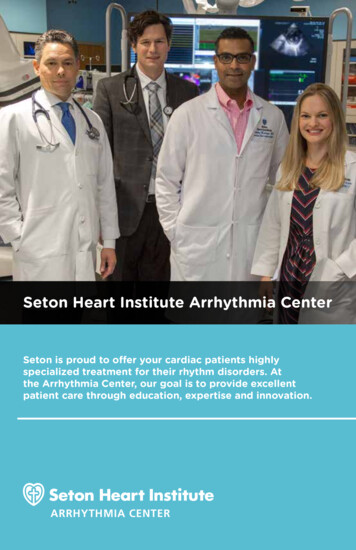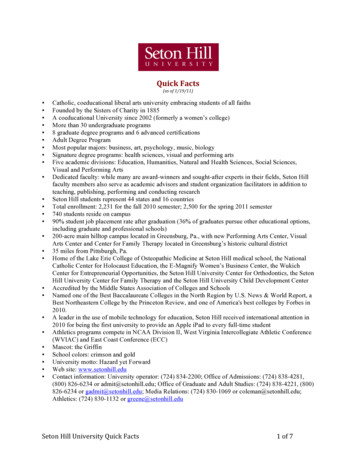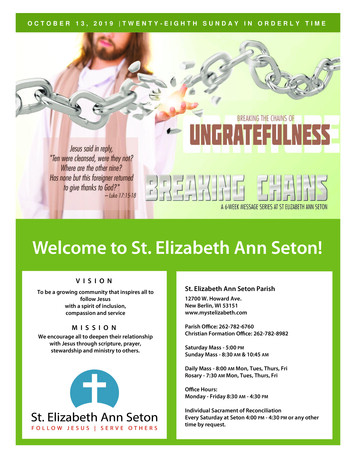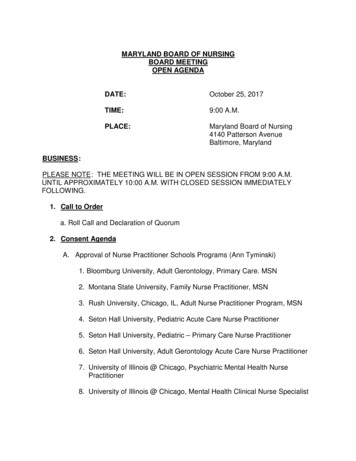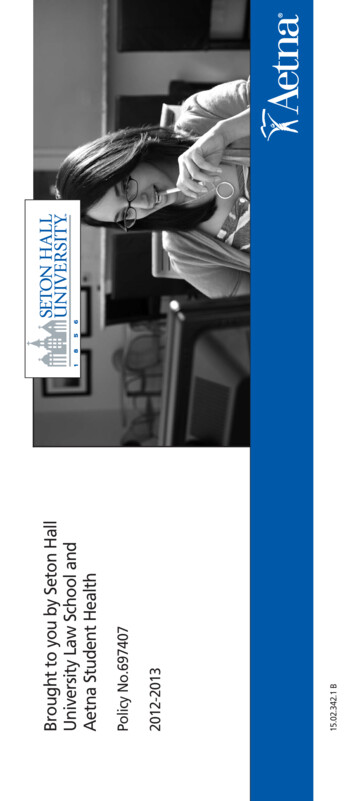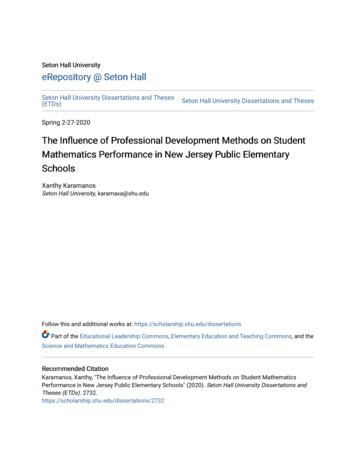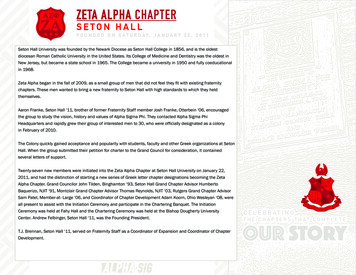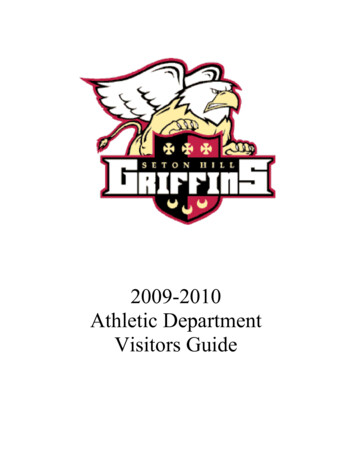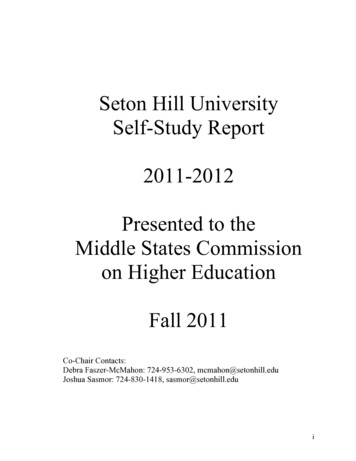
Transcription
Seton Hill UniversitySelf-Study Report2011-2012Presented to theMiddle States Commissionon Higher EducationFall 2011Co-Chair Contacts:Debra Faszer-McMahon: 724-953-6302, mcmahon@setonhill.eduJoshua Sasmor: 724-830-1418, sasmor@setonhill.edui
Table of ContentsPageExecutive Summary and Eligibility Certification StatementMajor Findings and RecommendationsEligibility Certification Statement11Introduction to Seton Hill UniversityThe InstitutionEmbracing ChangeThe Self Study ProcessProposed OutcomesCommittees and the Self Study Process22778Standards 1-14Chapter I: Embracing the MissionStandard 1: Mission and GoalsChapter II: Charting the CourseStandard 2: Planning, Resource Allocation, and Institutional RenewalStandard 3: Institutional ResourcesChapter III: Celebrating LeadershipStandard 4: Leadership and GovernanceStandard 5: AdministrationChapter IV: Delivering on PromisesStandard 6: IntegrityStandard 8: Student Admissions and RetentionChapter V: Creating BelongingStandard 9: Student Support ServicesChapter VI: Expanding ExpertiseStandard 10: FacultyChapter VII: Offering Depth and BreadthStandard 11: Educational OfferingsStandard 13: Related Educational ActivitiesChapter VIII: Refining the Liberal ArtsStandard 12: General EducationChapter IX: Assessing PerformanceStandard 7: Institutional AssessmentStandard 14: Assessment of Student Appendicesii
Executive Summary and Eligibility Certification StatementMajor Findings and Recommendations[This executive summary will include a 1-5 page description of the major findings andrecommendations of the study. We’ll compose this after community-wide and steeringcommittee feedback.]Eligibility Certification Statement[The Certification Statement must be attached to the Executive Summary]1
Introduction to Seton Hill UniversityThe Institution:Seton Hill is a Catholic liberal arts institution founded by the Sisters of Charity in 1885and located 30 miles east of Pittsburgh, Pennsylvania. The University follows thetradition of Elizabeth Ann Seton, pioneer Catholic educator and the first American-bornsaint. The spirit of the founders – humility, simplicity, charity, and the remembrance thatGod is ever present – continues to influence the life of the University today. Seton Hillprovides a broadly based educational experience fostering intellectual, social, ethical, andspiritual development in a student-centered community environment. The University iscommitted to liberal arts education as well as to serving as a center for professionaladvancement for students who seek baccalaureate or post-baccalaureate opportunities thatare of relevance to the changing needs of their careers and of society. Seton Hillrecognizes that the skills needed for success must be founded on the analytical andcritical thinking skills that the liberal arts engender and be integrated with professionalpreparation. Capable citizens of a global community also need a vision informed byspiritual and ethical values to guide them in the active transformation of their world.Seton Hill enrolls approximately 2,100 students and serves the community as a source ofleaders in the fields of business, education, government, health care, natural sciences,social sciences, and visual and performing arts. Seton Hill also provides culturalresources and enrichment, and acts as a partner in economic development. The MiddleStates Association of Colleges and Schools accredited Seton Hill University in 1921.Embracing ChangeSeton Hill has experienced many pivotal changes since its last reaccreditation, includingthe following: moving from College to University; actively recruiting men into a fully coeducational institution; seeing major growth in enrollments across all student populationsbut especially traditional undergraduate students; adding new academic programs,expanding athletic opportunities; developing collaborations with local, regional, andnational organizations; creating partnerships to provide medical programs on Seton Hill’s2
campus; expanding campus facilities to meet students’ physical, intellectual and artisticneeds.Co-educational and UniversitySeton Hill College became Seton Hill University in July 2002 and officially beganmarketing itself as a coeducational university at this time. The changes to university andcoeducation have called for major adjustments that the University community hasembraced successfully.Enrollment Growth and DemographicsSince the last Middle States self study, Seton Hill has noted strong fiscal improvements.Enrollments have increased dramatically for traditional undergraduates in recent years. Inthe past ten years the overall student population has grown from 1,261 students in fall of1999 to 2,145 students in fall 2009. Seton Hill students come from diverse ethnic,religious, and economic backgrounds. They range in age from traditional students (18-22)to the returning student and those entering college later in life. The traditional dayuniversity has approximately 1,500 students. The University's adult degree program(ADP) has an enrollment of approximately 250. Enrollment in the University’s graduateprograms is currently around 400. Traditional program undergraduate students comefrom 43 states and 12 foreign countries. Seton Hill’s students are diverse, with 12%overall and 21% of freshmen belonging to minority groups. The minority enrollment hasbeen between 11 and 19 percent since 1990, which is high for Westmoreland County,Pennsylvania, where 96.4 percent of the population is Caucasian (U.S. Census BureauStatistics for 2005). Among traditional students, 33% are male and 67% are female.New Academic ProgramsResponsive to the needs of the region and its students, Seton Hill University offers over30 undergraduate majors, eight master’s degree programs and several graduatecertificates. By providing advanced study within a liberal arts context, the Universitycontributes to the preparation of highly qualified professional women and men whoseeducation will enable them to meet the challenges of the contemporary workplace and to3
enjoy fruitful personal and professional lives. With the initiation of graduateprogramming as well as the adult degree program, Seton Hill University is at theforefront of service to learners of all ages in southwestern Pennsylvania. It is the aim ofthe University’s faculty and administration to provide each student with a complete andfulfilling academic experience that will serve as a foundation for a lifetime of learning.Seton Hill University's strategic plan stresses diversification of degree programs, and allefforts to date have emphasized programs that serve the region as well as build upon theUniversity's well-established strengths.Since 2002 Seton Hill has begun undergraduate majors in: Criminal Justice, ForensicScience, Music Therapy and Sports Management. It also closed programs in Family andConsumer Sciences (Early Childhood Studies), Management (Technical), Nursing (2 2),and the Family Studies major. Faculty approved the initiation of two post baccalaureatecertificates in Genocide and Holocaust Studies and Orthodontics; a Master of Arts inInclusive Education; the changing of degree from a BS to BS/MS or MS in PhysicianAssistant, MA in Counseling Psychology to the MA in Marriage and Family Therapy, anMS to MBA in Management and MA to MFA in Writing Popular Fiction. The MA inInstructional Design for Technology Enhanced Learning was closed. A BusinessEducation Teaching Certification was added. BS/DO and BS/DPharm programs wereadded with the Lake Erie College of Osteopathic Medicine.Seton Hill has judiciously and successfully expanded on-line offerings during this period.The Genocide and Holocaust Certificate and the Inclusive Education Program are offeredfully on-line. In addition, students can take the liberal arts curriculum through on-linestudy during the summer session as well as selected courses in the majors throughout theyear.Partnering for SuccessA continuous effort to serve the needs of both students and the region’s residents is partof Seton Hill’s rich history of community involvement. Community, regional andnational partnerships continue to provide important opportunities for the university.4
1. In the spring of 2001 Seton Hill University invited the City of Greensburg, theGreensburg Salem School District, the Redevelopment Authority of the County ofWestmoreland, Westmoreland County, local legislators, and the WestmorelandCultural Trust to explore the feasibility of doing projects together to renewdowntown Greensburg. The project Seton Hill University proposed, and whichthe partners embraced, was the construction of a performing arts center that wouldhouse the University’s programs in theatre and music. The project, with its strongcommunity partnerships, has garnered attention and support from all levels ofgovernment, as well as local and national foundations, corporations, alumni,trustees, and individuals. Throughout Pennsylvania, Seton Hill’s project is beingpresented as a model of the way universities can drive economic development incommunities. At the 2006 Pennsylvania League of Cities and MunicipalitiesAnnual Convention, Seton Hill’s project was featured as an example of the wayuniversities and local governments can collaborate to bring about long-termpositive change. The project will also be featured as a case study in a state manualbeing prepared for Pennsylvania mayors and county commissioners.2. In the spring of 2008, Seton Hill signed a joint agreement with the Lake ErieCollege of Osteopathic Medicine (LECOM) that now offers medical training forstudents on SHU’s campus. The agreement provides an important revenue streamfor SHU, and it also contributes to the University’s growing academic reputationby guaranteeing acceptance into the medical school for qualifying incoming SHUfreshman.3. In 2010 the University reaffirmed its partnership with the Diocese of Greensburg,Pennsylvania to offer a certificate in Pastoral Ministry in conjunction with SetonHill University’s religious studies/theology program. In addition, the Diocese hasagreed to a long-term lease in the Bishop Connare Center that will house SHU’snew Orthodontics certificate program.AthleticsCollaborative endeavors, as well as becoming co-educational, have enabled Seton Hill torecruit increased numbers of academically talented male and female undergraduate5
students from around the nation. On average, 35% of these students choose to compete invarsity sports. On March 8, 2006 Seton Hill announced its move to Division II of theNational Collegiate Athletic Association (NCAA) and the West Virginia IntercollegiateAthletic Conference (WVIAC). The University completed its competition schedule withthe National Association of Intercollegiate Athletic (NAIA) American MideastConference in 2006-2007 and played its first full conference regular season schedule withthe WVIAC in 2007-2008. Seton Hill’s athletic programs have produced All-Americansin soccer and football, All-Regional volleyball and baseball players, and numerous AllConference Awards. Seton Hill is especially proud of its many Academic All-Americansfrom each team. Seton Hill currently offers 19 varsity sports – 11 women, 8 men –including men’s and women’s soccer, basketball, women’s tennis, women’s golf, men’sand women’s cross country, and lacrosse; women’s field hockey, volleyball, equestrian,and softball; men’s baseball and football. The 2006-2007 academic year marked theinaugural year for wrestling, and men’s and women’s track and field. The result of thesechanges is growing enrollment and a vibrant student body.ExpansionWith growing enrollment has also come the need for campus improvements. Thanks togenerous donor and foundation support, the University’s Achieving the Dream Campaignhas allowed Seton Hill to construct two new residence halls, renovate Saint Joseph’sChapel, and construct both a large Athletic Center on campus, and a Performing ArtsCenter located in the middle of our local downtown community. Seton Hill has receivednational foundation support from the Kresge and Teagle Foundations, among others, andthrough the U.S. Department of Education Title III programs the University has been ableto add a permanent position for an Institutional Researcher within our campuscommunity, as well as offer innovative technological opportunities to faculty andstudents. In recent years the University has invested in technology that focuses onstudent learning in all academic areas. During the summer of 2009 the entire Seton Hillcomputer network infrastructure was replaced with cutting edge routing and switchingequipment to build a new foundation to support the technological initiatives. The firstthing built on this new foundation was a campus wide wireless network. This network6
gives students, faculty and staff the ability to utilize the campus network resources fromany location. With this sort of freedom also comes an added layer of security. Theuniversity invested in new network access controls and intrusion detection systems thatprotect the growing network from unauthorized access and abuse. The university’sInternet connection was upgraded to a full gigabit fiber connection with a Level 3Internet backbone. This service also includes a gigabit fiber link to a remote data centerin Pittsburgh. In the spring of 2011 this location will be used for off-site backups and as adisaster recovery facility.In the fall of 2010 Seton Hill began a new technology program, The Griffin TechnologyAdvantage. This program supplies all in-coming full-time first-year students with aMacBook computer and an iPad companion device. Within four years, all SHU studentswill have access to the most advanced educational technologies. As of fall 2010, allupper-class full-time students also received an iPad to use throughout their time at SetonHill. This initiative has made it possible for faculty and staff to incorporate the latesttechnology into curriculum and programming for all Seton Hill students.The Self Study ProcessProposed Outcomes: To compose a clear, thoughtful, and successful self-study that addresses SetonHill’s strengths and challenges, and lays a foundation for future success andplanning. To demonstrate compliance with the fourteen Middle States Standards and toachieve reaccreditation. To create an analysis that leads to improved student learning and engagement. To foster and expand a culture of self-assessment that encourages everyone to bereflective, to collect data, and to use data analysis to guide decisions. To refine our vision for future direction and to communicate this vision to allstakeholders To achieve full community participation in the self-study process.7
Committees and the Self Study Process:The self-study organization included a thirteen-person steering committee consisting oftwo co-chairs, the chairs of the nine distinct working groups (one group has two cochairs), and the Institutional Researcher. The membership of the Steering Committee andthe Working Groups are listed below, along with titles and institutional roles. Sevenmembers of the steering committee are faculty members, three are administrators, andthree are professional staff. Each working group was responsible for demonstratingcompliance with particular Middle States Standard(s) as found in Characteristics ofExcellence in Higher Education. The working group members were appointed by thePresident of the University, at the recommendation of the co-chairs of the SteeringCommittee and the Provost. Each working group was chosen to represent as many of thedifferent campus constituencies as possible: faculty, staff, and administrators. Someworking groups were composed via sub-committees of standing University committees,such as the Liberal Arts Committee and the Mission Effectiveness Committee. Theworking groups solicited participation from students, both by role via student governmentand by individuals via focus groups. For example, Standards 4 & 5 included a studentmember (Student Council President); Standard 9 incorporated discussions withrepresentatives from the Student Government Association, and Standard 12 heldnumerous focus groups with students representing various constituencies.The work of the committees proceeded as follows: In Fall 2009, the steering committeeconducted a campus-wide survey related to the Characteristics of Excellence (Survey).In Spring 2010, the Steering Committee chairs and their working groups developed draftresearch questions based on the survey results, discussion, and SWOT analyses of thestandards in order to focus their analysis of the University. In spring, summer and fall2010 the working groups identified documents needed for discovery and evidence, anddetermined how to meet the criteria for each standard through responses to the researchquestions. They completed draft reports, which were submitted by December 2010.Meanwhile, the Steering Committee served to organize and facilitate the self-studyprocess. The steering committee helped refined the research questions (spring 2010),8
reviewed regular progress reports (summer 2010 and fall 2010), reviewed drafts ofworking group narratives (fall 2010), and finally hosted many community forums todiscuss feedback on each standard from diverse campus constituencies (spring 2011).Open forums were held for each Standard, as well as for the self-study as a whole, andcommunity members were also invited to provide feedback via an online Self-study blog.Individual Standards were also presented to various standing committees of theUniversity for discussion. A final draft of the report, including action plans andrecommendations, was created by the steering committee based on feedback from theopen forums, the online blog, and standing campus committees.Composition of the Steering Committee:Debra Faszer-McMahon (Co-Chair), Assistant Professor of Spanish; Joshua Sasmor (CoChair), Associate Professor of Mathematics; Terry Brino-Dean, Associate Professor ofTheatre and Director of the Theatre Program; Edith Cook, Institutional Researcher;Terrance DePasquale, Dean of Graduate and External Programs, Professor ofEducation; David Droppa, Associate Professor of Social Work; Paul Edsall, Controller;Mary Ann Gawelek, Provost and Dean of the Faculty, Professor of Psychology;Lawrence Jesky, Associate Professor of Psychology, Faculty Athletics Representative;Frances Leap, Associate Professor of Religious Studies/Theology; James Paharik,Associate Professor of Sociology; Sr. Lois Sculco, Vice President for Mission andStudent Life; Charmaine Strong, Dean of Students.Composition of the Working Groups1. Mission and Goals: Chair: Frances Leap, Associate Professor, ReligiousStudies/Theology; Committee Members: Michael Arnzen, Professor, English andChairperson of the Division of Humanities; Jamie Fornsaglio, Associate Professor,Biology; Sr. Dorothy Jacko, Associate Professor, Religious Studies/TheologyWilda Kaylor, Associate Director for the National Catholic Center for HolocaustEducation; Marcia Pratt, Associate Dean of Student Life/Director C.A.P.S.; GerardSheridan, Director, Project Forward; Molly Robb Shimko, Associate Vice President forInstitutional Advancement.9
2. Planning, Resource Allocation & Institutional Renewal, 3. Institutional ResourcesChairs: Mary Ann Gawelek, Provost and Dean of the Faculty with rank of Professor;Paul Edsall, Controller; Committee Members: Steven Bassett, Associate Professor,Biology; Theodore DiSanti, Associate Professor, Music; Sr. Victoria Marie Gribschaw,Associate Professor, Family and Consumer Sciences and Chairperson of the Division ofSocial Sciences; Barbara Hinkle, Vice President for Enrollment Services and RegistrarFrank Klapak, Professor, Communications and Education; Philip Komarny, ExecutiveDirector of Computer and Information Technology; Christopher Snyder, ExecutiveDirector for Athletic Programs4. Leadership and Governance, 5. Administration: Chair: Sr. Lois Sculco. VicePresident for Mission and Student Life; Committee Members: Mary Ann Aug, Board ofTrustee member; Carol Billman, Director of Grants and Government Support; KatieFritsch: Student Government (SHGA) President; Sr. Vivien Linkhauer, Board of Trusteemember and President of the Sisters of Charity; Christine Mueseler, Vice President forAdvancement and Marketing; Darlene Sauers, Manger of Human ResourcesJohn Spurlock, Professor, History and President (2010-2012), Faculty Senate; MarilynSullivan-Cosetti, Associate Professor, Social Work and Director of Social Work andPresident (2006-2010), Faculty Senate.6. Integrity, 8. Student Admissions and Retention: Chair: Lawrence Jesky – AssociateProfessor, Psychology and Faculty Athletics Representative; Committee Members:Rebecca Baker, Manager of Communications and Web Content; Tracey Bartos, Directorof Graduate and Adult Studies; Sherri Bett, Director of Admissions; Christopher Diaz,Associate Professor, Computer Science; Maryann Dudas, Director of Financial AidKeisha Jimmerson, Assistant Director of Residence Life and Director of InterculturalStudent Services; Janice Sandrick, Associate Professor, Dietetics9. Student Support Services: Chair: Charmaine Strong, Dean of Students; CommitteeMembers: Robin Anke, Associate Dean of Students and Director of Residence Life;10
Teresa Bassi-Cook, Director of Counseling, Disability and Health Services; David Brant,Program Advisor; Bruce Ivory, Associate Athletic Director for Compliance and InternalAffairs; Paul Mahady, Assistant Professor, Business and Coordinator of UndergraduateBusiness Majors; Kimberly Pennesi, Coordinator of Writing Center; Anastasia Tircuit,Associate Professor, Computer Science.10. Faculty: Chair: Terry Brino-Dean, Associate Professor, Theatre and Director of theTheatre Program; Committee Members: Kathleen Campbell, Associate Professor,Music; Michael Cary, Professor, History/Political Science; John Cramer, Professor,Chemistry; Lloyd Gibson, Assistant Professor, Business and Program Director, MBASr. Mary Kay Neff, Associate Professor, Art and Director of the Art Program; LeeMcClain, Professor, English; Roland Warfield, Assistant Professor, Business/Accounting11. Educational Offerings, 13. Related Educational Activities: Chair: James Paharik,Associate Professor, Sociology and Coordinator of Human Services; CommitteeMembers: Kelly Clever, Public Services/ILL Librarian; DeMarquis Clarke, AssistantProfessor, Marriage and Family Therapy and Director, Clinical Training; Jayne Huston,Director, E-Magnify; Dennis Jerz, Associate Professor, English; Sarah Livsey, AssistantProfessor, Criminal Justice; Sharon Mills, Assistant to the Vice President for EnrollmentServices and Registrar; Mary Spataro, Instructional Designer, and Instructor, EducationMichelle Walters, Director of Community Music.12. General Education: Chair: David Droppa, Associate Professor, Social WorkCommittee Members: Geoffrey Atkinson, Assistant Professor, Mathematics; PatriciaBeachley, Associate Professor, Art; Constance Beckel, Associate Registrar; Carol Brode,Assistant Professor, Art and Director, Harlan Gallery; Michelle Chossat, AssociateProfessor, French; Susan Eichenberger, Associate Professor, Sociology; Judith GarcíaQuismondo, Associate Professor, Spanish; Catherine Giunta, Associate Professor,Business; Frances Leap, Associate Professor, Religious Studies/Theology; DanielMartino, Assistant Professor, Theology; James Paharik, Associate Professor, Sociologyand Coordinator of Human Services; Laura Patterson, Associate Professor, English and11
Director of Undergraduate Writing Programs; Adam Pellman, Acquisitions/CatalogingLibrarian; Denise Pullen, Associate Professor, Theatre; Jaimie Steel, Assistant Dean ofStudents; Maureen Vissat, Assistant Professor, Art.7. Institutional Assessment, 14. Assessment of Student Learning: Chair: TerranceDePasquale, Dean of Graduate and External Programs, Professor of Education;Committee Members: Alvaro Barriga, Associate Professor, Psychology; Edith Cook,Institutional Researcher; Dana Elmendorf, Assistant Professor, Art Therapy; DanielMcCarty, Head Men’s Soccer Coach; Audrey Quinlan, Associate Professor, Educationand Program Director, Graduate Elementary Education; Doina Vlad, Associate Professor,Business; Sr. Susan Yochum, Professor Chemistry and Chairperson of the Division ofNatural and Health Sciences.Standards 1-14Chapter I: Embracing the MissionSTANDARD 1:Mission and GoalsOverview of the charge.The working group for Standard 1, “Embracing the Mission,” is charged by the MiddleStates Steering Committee to study and report on the mission of Seton Hill Universityand statements of institutional goals. This is relevant to demonstrating compliance withthe Middle States Standard 1.Seton Hill is a Catholic university rooted in Judeo-Christian values. In the tradition ofElizabeth Ann Seton, we educate students to think and act critically, creatively, andethically as productive members of society committed to transforming the world.- Seton Hill University Mission StatementHow has the mission informed the developments of the University in the past decadeand how does the work of the mission continue to be reflected in them?12
The Seton Hill University mission statement underwent a formal review and revisionprocess in 2002 through the work of a committee whose membership includedadministration, trustees, and faculty. Their work was presented to the larger Universitycommunity at a Fall Workshop; and the feedback obtained there led to a final statementthat was approved by the Board of Trustees in February 2003 (Mission Report). Thatmission statement has been the foundation and guide of the University in its changes ofthe past decade. It is from the mission that the strategic plans are drawn each time and itis from the mission that the University Learning Objectives have been formulated. Thestrategic plans have guided major developments of the university over the past decade,such as moving to a fully co-educational institution, establishing an athletic program forwomen and men, developing of graduate programs, renewing support for establishedcenters, adding certificate programs, and increasing training opportunities for faculty.The commitment of Seton Hill to the centrality of the University mission in its dailyendeavors has been highlighted by the appointment of a Vice President for Mission andStudent Life in 2007, reinforcing the work of the Mission Effectiveness committee for 13years (BOT minutes 6/07). The Vice President for mission and student life has served tointegrate mission across the campus and hold it front and center throughout the strategicplanning processes. Additionally, in February 2010, the University Board of Trusteesapproved the establishment of a new board committee, chaired by a Sister of Charity andcharged with responsibility for the Catholic Setonian Mission and Identity of theUniversity (BOT Minutes 3/10).As part of the decision to become a fully co-educational institution, Seton Hill Universitychose to become part of the National Collegiate Athletic Association (NCAA) at theDivision II level recognizing that its student-first approach would underscore theUniversity’s mission. NCAA Division II provides student-athletes with a firm path tograduation, while cultivating key attributes – learning, balance, spirit, community, fairplay, and character – which serve student-athletes for a lifetime and align with SetonHill’s mission of educating students to transform the world. Student-athletes are13
ambassadors of the Seton charism of service, completing more than 2,600 hours ofcommunity service in 2008-09 for a variety of local organizations (Athletic Service).In 2008 Seton Hill University took a major step in its mission to transform the world, as itbecame an additional location for the nation’s largest medical school, the Lake ErieCollege of Osteopathic Medicine (LECOM). Recognizing the looming health care crisisthat is facing southwestern Pennsylvania, fueled by an aging and underserved population,insufficient funding, and a shortage of medical professionals, LECOM and Seton Hillhave partnered to expand medical education in the region and thereby increase thepercentage of medical school graduates who are likely to remain in the area to serve theneeds of rural communities. Seton Hill’s Board of Trustees recognized how well themission of LECOM aligns with that of the University and the opportunity this partnershipprovided to strengthen undergraduate and graduate programs in the natural and healthsciences, as well as foster expanded strategic alignments with regional medical careproviders (PA Health Report).Also aligned with the University’s mission to serve the underserved is Seton Hill’sOrthodontics Program. Three years ago, the last program in the region to offerorthodontic services for those of low income closed its operations. In addition toeducating future practitioners from across the country, the Seton Hill OrthodonticsProgram serves regional patients who could otherwise not afford treatment through theorthodontic residency program (Ortho Fact Sheet).The passion at Seton Hill for the visual and performing arts blossomed in 2009 with theopening of the Seton Hill University Performing Arts Center. The mission is well servedby the critical and creative work that is accomplished in world-class performance andinstructional settings, transforming the lives of students, the community of Greensburg,the arts culture of Westmoreland county, and continuing the tradition of Catholic supportfor the arts. Elizabeth Ann Seton and her husband William were both accomplishedmusicians. A portrait of Elizabeth as a mother with her young son, hangs in a prominentlocation at the concert hall in the new Center.14
The tradition of Elizabeth Seton and the Sisters of Charity has been reflected historicallyin Seton Hill University’s commitment to
the WVIAC in 2007-2008. Seton Hill's athletic programs have produced All-Americans in soccer and football, All-Regional volleyball and baseball players, and numerous All-Conference Awards. Seton Hill is especially proud of its many Academic All-Americans from each team. Seton Hill currently offers 19 varsity sports - 11 women, 8 men -
